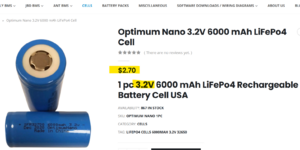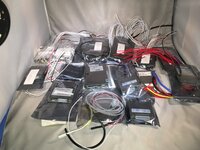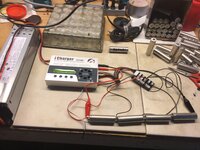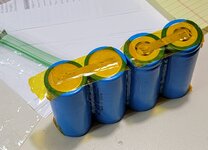I think ebikes are in the Bubble stage, but with all the money people are imagining they are making on their houses, it will continue. I’m going to sell my house and live in a box, but I haven’t found the box I want yet.
I think that ebikes will go back to a better mix of manufactured and DIY. I particularly think that ebike companies have done a swell job of making non-standard ebike packs off limits. And those companies are not competing. Prices are very similar from company to company. You have to consider this cell from Optimum Nano. The company is substantial, and it was in trouble a few years ago. It’s Chinese and the cell is LFP. At $2.70 for a 6 AH cell, you can get a lot of watt hours for a small amount of money. You need 16 in series to make a 48 volt pack, but the voltage is higher than that. If you take two sets of 16, so 2p16s, you have have 32 cells. The cost for the cells is about $86, but there is tax and shipping, but you can see the basic cost outlines.
This 32 cell pack is 12 amp hours, 2 sets of 6 AH cells. That’s a decent pack and if you do a run down test you will see that the watt hour figure is very solid. These cells hold their voltage. They are more fun to ride with because the voltage is quite steady, not dipping so much.
The real question is one of assembly. These are big cells, maybe huge cells next to an 18650. But that makes them easy to weld. Will people actually spot weld these cells? I don’t know. The welder is not an incidental. Right now, there is not much interest in welding. So, it would depend on having ebikes return to more of a DIY environment. All that would take is some economic pressure shifting the market down to poor people, which it isn’t right now.
To me, the best thing you could do for poor people is give them basic houses and basic transport. Then they can work and be OK economically. I remember when the county I live in decreed that you couldn’t live in a cheap mobile, a cheap RV, anything that wasn’t up to their standards of wealth. Now we know where that goes. Oakland will let you live in these options, and the prefab tiny house looks good in a lot of ways. If you look at movies from the 50’s or 60’s, there was a lot of basic housing. Now the rich can’t handle it, and they are sick of the homeless. But back to transport.
The best way to sell these LFP cells, the 32700 cells, would be to assemble them in modules. Micah Toll once had a crowdsource where he offered small modules of assembled cells, which could be soldered. He took a lot of heat and the idea died. If you simply took a machine spot welder and assembled these Nano cells into 16 series, you’d almost have an ebike battery, but a small one. If you put XT60 connectors on the modules, you could parallel them effortlessly. As far as balance leads or a BMS, I don’t know. A basic connector and an external BMS would be simple. Most batteries have protections from the charger and the controller. So, if you took two modules and paralleled them, you’d have a standard ebike battery.
Certainly this approach is open to criticism. It’s a CNC type welding process. It’s a safe cell that is rated for 2,000 cycles. I’d like to see the issues, but I don’t see anything that is a real business because it’s something anyone can do. I would note that the $2.70 per cell is US retail. I mean, if you go buy a few thousand in China, it could be quite a bit lower.
Battery Hookup is essentially doing this with a 32700, but he’s assembling 20 in parallel, a little brick with a lot of amp hours and low voltage. But he sells them in sets of 4 which makes a standard 12v battery, like for an RV cabin deep cycle.
Something is going to break the death grip of US ebike companies on the pack market. This is essentially a ‘hundred dollar’ pack that offers advantages at the price of bulk. For an ebike for people with limited incomes, it probably works. It’s not really a hipster pack.








